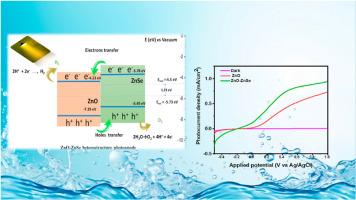Improved PEC performance of SILAR grown ZnO Nanorods by selenization to form ZnO-ZnSe heterostructure
IF 4.9
3区 材料科学
Q2 CHEMISTRY, MULTIDISCIPLINARY
引用次数: 0
Abstract
Type-II ZnO-ZnSe heterostructure is formed through surface selenization using an ion-exchange process of SILAR grown ZnO nanorods. This process aims to raise the photoelectrochemical cell (PEC) performance of ZnO nanorods photoanode. The thickness of the ZnSe layer is optimized by varying the Se: NaBH4 ratios during the ion-exchange process.
The ZnO-ZnSe heterostructure formation was validated by Raman spectroscopy and X-ray photoelectron spectroscopy studies. Scanning electron microscopy images demonstrated that the ZnSe nanoparticle formation caused the original ZnO nanorod shape to diverge. Photoluminescence confirmed ZnO-ZnSe heterostructure as like UV-vis absorbance `spectroscopy. The I-V characteristics, chronoamperometry (ON/OFF), electrochemical impedance spectroscopy and Mott-Schottky measurements show all-inclusive increment in the PEC performance as a result of surface selenization of the ZnO nanorods photoanode. It is found that the ZnO-ZnSe heterostructure photoanode leverages of extreme photocurrent 0.94mA/cm2 at 1V vs. Ag/AgCl and a photoconversion efficiency of 0.19 % at 0.89 V vs. RHE. The type-II alignment between ZnO and ZnSe bands result in improved charge collection and a lower recombination rate leading to ZnO-ZnSe heterostructure's enhanced photoelectrochemical performance.

硒化ZnO纳米棒形成ZnO- znse异质结构,提高了ZnO纳米棒的电化学性能
ii型ZnO- znse异质结构是通过SILAR生长的ZnO纳米棒的离子交换过程进行表面硒化形成的。该工艺旨在提高ZnO纳米棒光阳极的光电电池(PEC)性能。在离子交换过程中,通过改变Se: NaBH4的比例来优化ZnSe层的厚度。通过拉曼光谱和x射线光电子能谱研究证实了ZnO-ZnSe异质结构的形成。扫描电镜图像显示,ZnSe纳米颗粒的形成导致了原ZnO纳米棒形状的偏离。光致发光证实ZnO-ZnSe异质结构与紫外-可见吸收光谱相似。I-V特性、计时安培(ON/OFF)、电化学阻抗谱和Mott-Schottky测量结果表明,ZnO纳米棒光阳极的表面硒化导致了PEC性能的全面提高。结果表明,ZnO-ZnSe异质结构光阳极在1V时相对于Ag/AgCl具有0.94mA/cm2的极值光电流,在0.89 V时相对于RHE具有0.19%的光电转换效率。ZnO和ZnSe之间的ii型排列改善了电荷收集,降低了复合速率,从而提高了ZnO-ZnSe异质结构的光电性能。
本文章由计算机程序翻译,如有差异,请以英文原文为准。
求助全文
约1分钟内获得全文
求助全文
来源期刊
CiteScore
7.80
自引率
2.50%
发文量
605
审稿时长
40 days
期刊介绍:
The Journal of Physics and Chemistry of Solids is a well-established international medium for publication of archival research in condensed matter and materials sciences. Areas of interest broadly include experimental and theoretical research on electronic, magnetic, spectroscopic and structural properties as well as the statistical mechanics and thermodynamics of materials. The focus is on gaining physical and chemical insight into the properties and potential applications of condensed matter systems.
Within the broad scope of the journal, beyond regular contributions, the editors have identified submissions in the following areas of physics and chemistry of solids to be of special current interest to the journal:
Low-dimensional systems
Exotic states of quantum electron matter including topological phases
Energy conversion and storage
Interfaces, nanoparticles and catalysts.

 求助内容:
求助内容: 应助结果提醒方式:
应助结果提醒方式:


